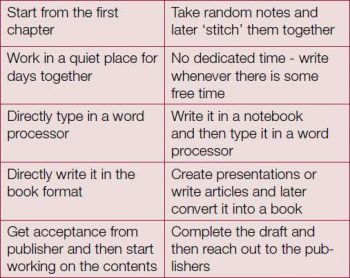
Writing a book can be both an exhilarating and an exhausting experience! It can help your career by giving you visibility, recognition from your community and set you apart as an achiever. Personally, you will get a sense of achievement and some additional income. Inspired by the line Anyone can cook! from the movie Ratatouille, the author believes that anyone can write! In this article, he outlines the book writing process, debunks common myths about book writing, and provides a realistic perspective on what it takes to write a book.
The first and foremost question you may ask yourself is, Why should I care about writing a book? Is the amount of effort and time I put into the task, worth it?
Here are some important reasons why you should consider writing your first technical book.
Reason 1: Get known
Writing a book earns you visibility, credibility and respect. A technical book will give you visibility in your area of work. You also enhance your credibility amongst your colleagues, friends and even relatives. Remember that most people consider authors of technical books as experts, and this perception matters. For example, you may get invited to give talks or keynotes and conduct seminars or training programmes if you become well known in your domain.
Reason 2: Learn and gain expertise
One of the best ways to learn and gain expertise in the topic you are interested in is to write a book on the subject! Realistically, writing a book will require you to focus on a specific topic for many months. If you choose a topic you are passionate about, you will get to learn about it. Whats more, its fun to spend time on something that you love, and thats a huge reward in itself!
Reason 3: Earn some extra income
When you write a book and publish it (through a traditional publisher), you get a regular income from royalty. Depending on the publisher and the terms of your contract, you will get these returns every three to six months, or on an annual basis. In India, royalty income up to Rs 300,000 is deductible from income tax (Section 80QQB)! When you have a day job and are earning a regular salary, this royalty becomes a secondary income (and any extra cash is always welcome, right?).
Reason 4: Get a sense of achievement
Writing a book requires commitment, focus and effort. When you finally deliver the manuscript to the publisher, you get a sense of having achieved a concrete result or crossed an important milestone. Look at writing your book as expressing your passion. Once you have written a book, you are always considered an author, and that adds weight to your resume. If you make it big, you can even leave behind a legacy.
In my experience, most people who love reading books are also interested in writing books of their own. However, what stops them from writing a book is their lack of knowledge (or fear) about the writing process. On a light note, here is a quote from Alice in Wonderland that describes the writing process: Begin at the beginning, the King said, very gravely, and go on till you come to the end: then stop. But I admit this isnt quite helpful if you are writing a book for the first time; so let us discuss the writing process in a step-by-step manner.
The writing process
Step 1: Getting an idea for a book
The first step when writing a book is to choose the right topic. Your ideal topic would be something that matches your interests, your skills and the markets need. For example, assume that you are interested in programming languages and your skills are related to creating mobile apps or writing games. Now, you need to find out the markets needswhat kind of technical books are in demand? To do that, analyse trends using Google analytics/trends, check the best-selling books in Amazon, find out about upcoming technologies from newspapers and blogs, etc. Now, you may find that books on certification, open source and those related to finding jobs are in high demand. By matching your interests and skills with what the market needs, you may find that ideally, the topic you ought to write on is developing games for Android using Java.
Step 2: Develop content
Once you finalise the topic of your book, you need to start working on developing the contents. Ignore the advice mentioned in Alice in Wonderland since it is a bad idea to directly start writing from the first to the last page! You can be creative regarding this part. When I write a book, I do various other things, apart from writing, yet all my efforts are focused on the topic of the bookI offer training sessions on the topic, write articles and blogs related to it, take notes when experimenting, read books on that topic, and even give presentations to my colleagues. In this way, I acquire content that has been looked at from various perspectives and keep getting feedback as I develop the book.
Step 3: Fill the book proposal form
Once you have a specific topic for a book and a fairly decent amount of content, it is the right time to talk to a publisher. You may opt to self-publish (these days, an increasingly large number of authors are taking this route), but I would recommend that you publish your first book with an established publisher. Why?
1. It will help you understand how to turn your draft into something that is production quality.
2. It will give you credibility among readers. People perceive getting published from a well-known publisher as a seal-of-approval for your work and will consider it seriously. As a first-time author, if you self-publish, that work is unlikely to be taken seriously.
Check out books in the market that are similar to the one you are writing to find out the names of publishers interested in your topic. Then go to their website or contact an editor from that publishing house and get the book proposal form (BPF). This is a sort of application to the publisher about the book you are writing. The contents of this form will help the publisher decide on whether or not to take on your book project. Iterate over it multiple times and revise it before submitting it to a publisher. Note that this is the key step in the publication process, so it would be good if you could put in considerable effort and focus on this task.
Step 4: Contact an editor
When trying to contact the editor of a publishing firm that you are targeting, check the publishers LinkedIn page, website or look for the editors names in the front few pages of the competing books. Send the BPF you have prepared with a couple of sample chapters, by email. If possible, talk to the editor over the phone to get some inputs before submitting the final proposal.
Step 5: Sign the contract and follow the production process
Once the publisher accepts the BPF, an acquisitions editor will send you a contract. Check the terms before signing the contract. Then, deliver the draft on the date you had promised in the contract. Once copy-editing and proof-reading is done, provide your inputs for the cover page design, sign the copyright documents, etc. Traditional publishers have documents that explain the book production process and developmental editors are also typically very helpful. So you dont need to worry too much if you dont understand the book production process. At this stage, just be mentally prepared to learn about the book production process and follow it.
Step 6: Celebrate your success
This may sound cheesy, but the best part of writing a book is getting it out in the market. So celebrate!
Step 7: Aggressively promote the book
Wait, you are not done yet! There is one more step; you need to aggressively promote your book. Here are some ideas:
- Request potential reviewers to write reviews (in magazines, blogs or Amazon.com)
- Reach out to potential bulk purchasers of your book (such as libraries and training institutes)
- Reach out to your readers (by writing articles, speaking at conferences, etc)
- Promote your book online (create a supporting book website, tweet or blog)
You may find it uncomfortable promoting yourself. But ask yourself this question, If I dont tell the world about my book, how will readers know about it and buy it? If you dont spread the word about your book, who else will? So, relax. It is okay to blow your own trumpet once in a while!
Book writing: facts and fallacies
There are many myths and fallacies about book writing. Consider these:
- You must be a born writer to write a book: Fallacy. Anyone can write a book (just as the rat Remy becomes a chef just by believing in the saying that Anyone can cook! in the movie Ratatouille). As Henry Ford said: Whether you think you can or think you cant you are right!
- You can become super rich by writing a book: Fallacy. Of course there are exceptions such as J K Rowling who made a fortune out of the Harry Potter books. But we are talking about technical books here — they dont sell in millions. Yes, you can make money, but not get super rich by writing a book.
- There is only one correct way to write a book: Fallacy. There are different ways to write a book. The writing approach that works for me may not work for you. So, find what works for you and stick with it. The following table lists the two different (but equally acceptable) ways to write the book.
Start from the first chapter Take random notes and later stitch them together
Work in a quiet place for days together No dedicated time – write whenever there is some free time
Directly type in a word processor Write it in a notebook and then type it in a word processor
Directly write it in the book format Create presentations or write articles and later convert it into a book
Get acceptance from publisher and then start working on the contents Complete the draft and then reach out to the publishers - You need to learn to use specialised writing tools before you write a book: Fallacy. Perhaps this is the most common myth about writing a book. To start with, word processing software (such as OpenOffice) is more than enough for writing your first book. Of course, there are many tools that can aid in your writing process and that can help improve your productivity. As you gain expertise as a writer, you can start to using such tools.
Tips for book writing
Based on hard-earned experience in writing books, here is a list of some tips to get started with writing your first book.

Tip 1. Plan ahead and allocate time to write your book
Most first-time authors underestimate the effort required to write a book. Here is a rule of thumb: if your initial estimate is X months to write your book, make it 2X monthsthat would be a realistic estimate of the time required to complete writing your book!
Tip 2. It takes a team to write a book – so find a co-author(s)
It typically takes many months (sometimes years) to write a book and it could get lonely. It is a good idea to work with someone with whom you are comfortable with. There are always exceptions (like Donald Knuth) who can write tomes on their own, but in general, partner with the right one(s).
Tip 3. Be prepared for rejections – but just move along!
Did you know that J K Rowlings Harry Potter series was rejected by 12 publishers? Agatha Christie struggled for five years before landing her first publishing deal! In general, be prepared for rejections from publishers. Its like attending job interviews – just move on.
Tip 4. Choose a topic that you are good at and are passionate about
Just because you are good at something doesnt mean you should write a book on it. If you are not passionate about the topic, the challenging task of writing the book will wear you out! Hence it is important to choose a topic that you are good at as well as something that excites and motivates you.
Tip 5. Write a book that is useful, helps people or makes a contribution
It could be teaching programming, a cook book, or just a bunch of tips and techniques. Ultimately, the book should help someone. Dont write a book just because you are an expert in that topic and want to write a book on it to get known.
Tip 6. Make sure your book has a USP (unique selling proposition)
A book is a product. A product gets an edge in the marketplace when it has a USP, which could be that it is the first book on the topic in the market, the only book on the subject, a novel approach to the topic, consolidates all the material in one book, is an easily accessible textbook that exactly matches the syllabus, etc.
Tip 7. Organise your thoughts using mind-mapping tools (and other available tools for writing)
Mind maps are especially effective in organising and streamlining your thoughts. Find and use such tools if they work for you. Figure 1 shows one such mind map image that Tushar Sharma created for the book we co-authored, Refactoring for Software Design Smells: Managing Technical Debt.
It can be both exhilarating and exhausting to write a book, but the rewards are worth the effort. So, what are you waiting for? Get a book idea, develop content and create a draft. And dont stop till your book goes out in the market. Then, promote it aggressively!

















































































